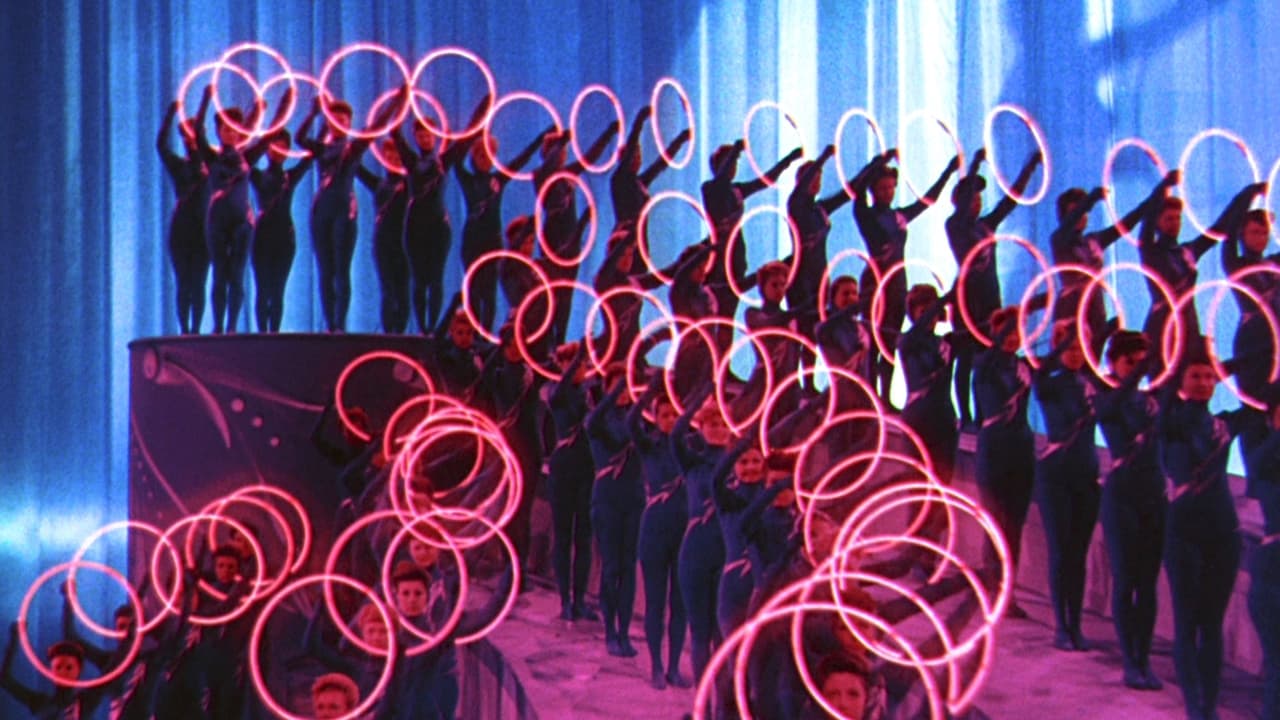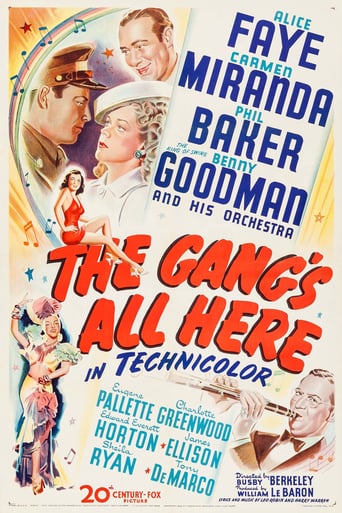

Nice 1943 film where James Elison two-times Sheila Ryan and Alice Faye. Yet, with the supporting cast, it really becomes a musical extravaganza, delightful and witty, with Carmen Miranda, with her usual fruit basket hats, witticisms and fracturing the English language-i.e.-the chips are down and turning around other common phrases, we have a delightful musical.She also states: "A block off the old chip."Alice Faye is in a revue and sings at a local Manhattan canteen for soldiers. Smitten by her soldier, she is brought to the home of Edward Everett Horton and Charlotte Greenwood, the former a successful businessman, the latter, his wife who has been concealing her stage Parisian past. Greenwood really lets loose with her long-legged hoofing.It's all fun to watch and the plot resolves itself in an unbelievably easy manner.
... View MoreA plot that's almost non-existent doesn't get in the way of some splashy knockout technicolor filmed musical number in The Gang's All Here. This marked Alice Faye's final musical film for 20th Century Fox. She would do one more movie that was without any songs for her in Fallen Angel and would leave Darryl F. Zanuck with Betty Grable and June Haver taking over for her and in the bullpen as Fox's reigning musical star.Leading man James Ellison is something of a dog here. While on leave even though he's engaged to Sheila Ryan, something that their rich fathers Eugene Palette and Edward Everett Horton have worked out, Ellison gives the big rush to chorus girl Alice Faye who falls hard for him and then abruptly leaves for the south Pacific where he becomes a war hero. How it all works out should be rather obvious.But all that is just a frame to hang a slew of musical numbers on. And of course Carmen Miranda is also here doing her famous Lady With The Tutti Fruitti Hat number along with the King Of Swing Benny Goodman and his orchestra. Harry Warren and Leo Robin wrote the original numbers for this film which include for Alice Faye a couple of her best loved songs, A Journey To A Star and No Love No Nothing.Busby Berkeley created the numbers and directed the whole film and with color his kaleidoscopic musical fantasies are quite an eyeful. The film should come with a warning label because if you are abusing any kind of substance that finale will lead your mind into some interesting places.Stay off whatever and then sit back and enjoy The Gang's All Here.
... View MoreThe only problem with The Gangs All Here is the plot. It keeps getting in the way of the production numbers. Busby Berkeley manages to shoehorn four major numbers in the just the first 30 minutes, and he doesn't let up much after that. These numbers include everything Busby Berkeley could think of, from Benny Goodman swinging "Minnie's in the Money" to Alice Faye singing "No Love, No Nothing'" to some bizarre extravaganzas featuring lots of thighs, bananas and Carmen Miranda. You'll want to hit the fast forward button at regular intervals to get past the dull parts between them. The story is corny, the romantic misunderstanding is...yawn... and the acting is often weak (James Ellison as the male lead) or prissily unfunny (Edward Everett Horton). Still, the Technicolor is as garish as you could want and the songs by Harry Warren and Leo Robin work well. There's little time to think of anything except the numbers and what Berkeley does with them. Says a commentator in one of the DVD's extras, "He was a dance director who couldn't dance. In a Berkeley production it was the camera that danced." I'm not sure anyone could watch "The Lady with the Tutti Frutti Hat" and not be in awe of how Berkeley not only made use of all those chorines with the giant fruit, but how he kept the action going using his camera in intricately plotted movement. If you watch the Tutti Frutti number a second time, see how many of the chorus dancers you can spot with grim determination, not smiles, on their faces as they lug those giant bananas around and struggle to hit their marks while the camera swoops and turns. The story? Alice Faye is a showgirl. James Ellison is a soldier, the son of a wealthy family soon off to the Pacific. They fall for each other, but he has a sort of girl friend. His parents and the girl's parents think they should get hitched. Will Alice and Jim work things out? They do after approximately 100 minutes. Among the relatives and friends are Carmen Miranda, Eugene Palette, Charlotte Greenwood and Horton, There are a number of reasons to watch this movie, especially if you're interested in Busby Berkeley. It turned out to be his swan song as a major force in the movies. For me, the production numbers are a lot of fun, but the best reason is that classic song by Warren and Robin that Alice Faye introduced... No love, no nothing' / Until my baby comes home. No fun with no one, / As long as baby must roam. I promised him I'd wait for him /Till even Hades froze. I'm lonesome, heaven knows, / But what I said still goes. This became one of America's great songs of longing during WWII. If you want to hear more of them, you can't do better than Jo Stafford and her CD, G.I. Jo - Songs of World War II.
... View MoreI always loved this flick as a kid, and as a teenager in the 70's assisted with the creation of a Busby Berkley cult club at high school. This is the grand-daddy of the gloriously crazy wartime divertissement, if you will. It is also regarded by many film historians to be Berkley's pinnacle-piece, and most exemplifies his uniquely surreal imagination.It has been a long wait to DVD - and while they have "remastered" and cleaned up the dust and noise from the original print - I am disappointed in the reduction of Technicolor saturation which in my mind, is one of this pictures' most important attributes. The intense, almost garish 40's postcard-colour density is completely intentional. Unfortunately, it has been discarded for more tonal realism. Some less patriotic 21st century technophile on the studio computer has been a little over-zealous in trying to create a colour palette that is more naturalistic...a bad, bad idea and this is NOT what the maker had intended for his first Technicolor feature(!)You can see a few snippets of the original colour saturation to compare in the special features section. The only thing to do is jack up your colour correction to 100% if you wish to come near the original. But even that is not enough on today's plasma televisions. Now, if they could only do something for the mono-sound quality. J. C. Carnovale
... View More